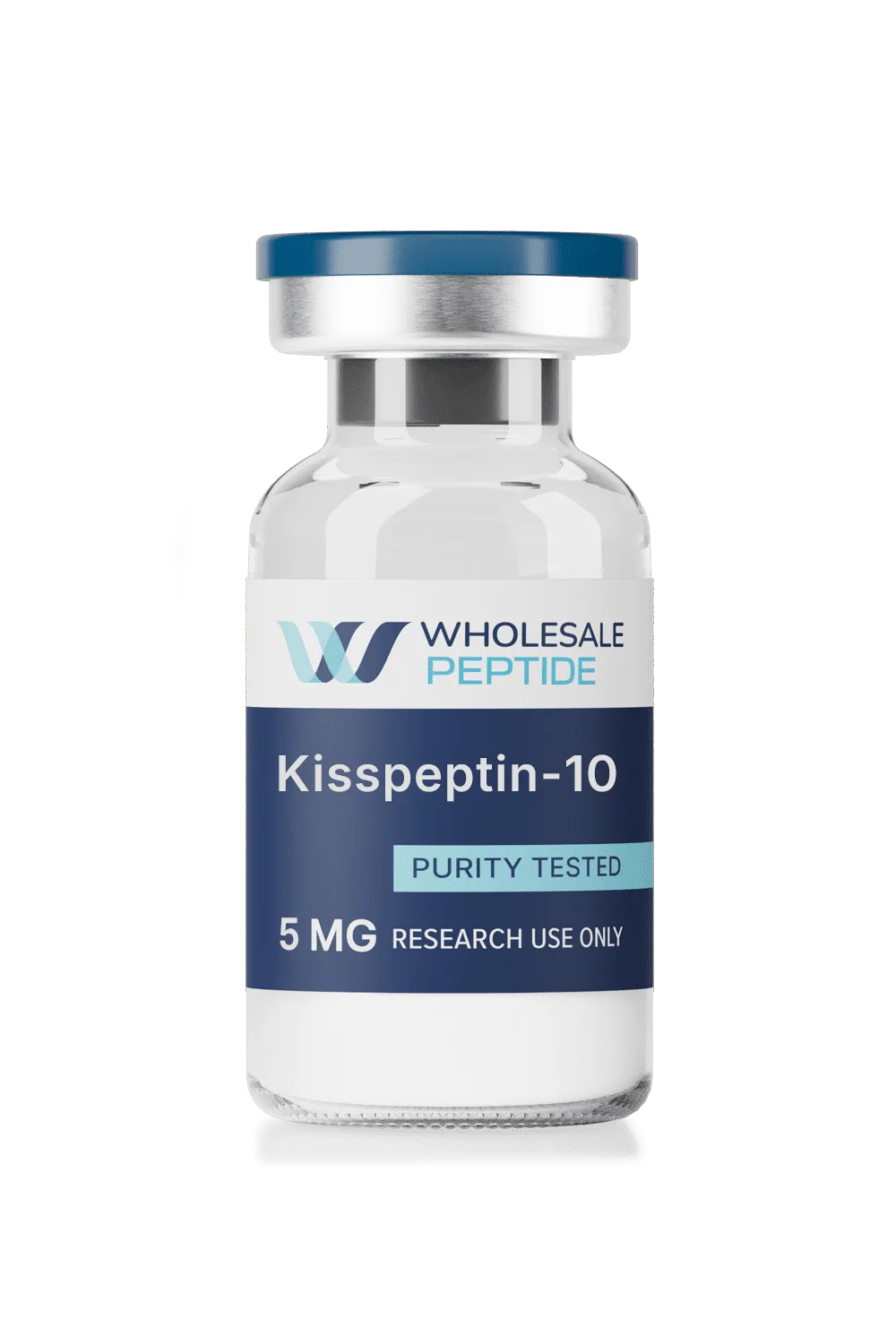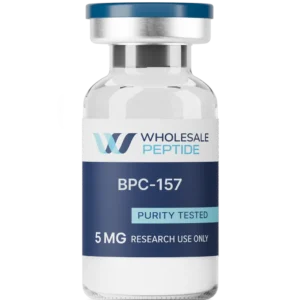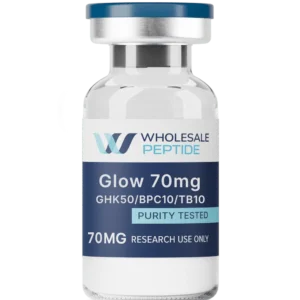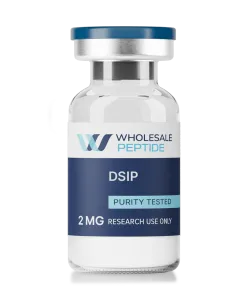Buy Kisspeptin-10 at Wholesale Peptide
Kisspeptin 10 is a research compound for scientists studying reproductive biology, endocrine signaling pathways and cellular mechanisms. This synthetic decapeptide, originally identified as a human metastasis suppressor gene product, has been shown to be important in experimental models of reproductive system function and hormone regulation. Research has shown this peptide to be involved in gonadotropin releasing hormone signaling and has been studied extensively in vitro.
Molecular structure of Kisspeptin-10
The peptide sequence of kisspeptin 10 is the minimal sequence required for receptor activation. Knowing the molecular structure is important for experimental design and solution preparation.
Amino Sequence: Tyr-Asn-Trp-Asn-Ser-Phe-Gly-Leu-Arg-Phe-NH2
Breaking down the sequence into segments:
- tyr asn trp: N-terminal tyrosine-asparagine-tryptophan
- trp asn ser phe: tryptophan-asparagine-serine-phenylalanine
- asn ser phe gly: asparagine-serine-phenylalanine-glycine
- ser phe gly leu: serine-phenylalanine-glycine-leucine
- phe gly leu arg: phenylalanine-glycine-leucine-arginine
- gly leu arg phe: glycine-leucine-arginine-phenylalanine
- leu arg phe nh2: leucine-arginine-phenylalanine-amide terminus
Molecular formula: C63H83N17O14
Molecular Weight: 1302 g/mol
Pubchem CID: 9941361
CAS #: 374675-21-5
The 1302 g/mol molecular weight allows you to calculate exact molar concentrations for your experiments. The amidated C-terminal is conserved across kisspeptin forms and is critical for receptor binding affinity. Research has shown this minimal sequence to have full biological activity compared to longer kisspeptin forms, making it a convenient choice for your research.Kisspeptin 10 works by binding specifically to the kisspeptin receptor (KISS1R/GPR54), a G-protein coupled receptor system. This binding triggers a cascade of cellular events that have been studied in experimental models.
Upon receptor activation the compound mobilizes calcium in target cells and activates gonadotropin releasing hormone gnrh neurons in hypothalamic tissue. Research has shown this activation affects over 85% of GnRH producing neurons in animal studies, making the peptide very potent in experimental systems.
The signaling pathway continues as activated GnRH neurons stimulate the anterior pituitary and release luteinizing hormone and follicle-stimulating hormone. This has been studied in various experimental models and research has shown the peptide increases plasma levels of these reproductive hormones in the test subjects.
Research has also looked at the compound’s role beyond reproductive function. Research has investigated its role in breast cancer metastasis where it may be a metastasis suppressor in certain experimental conditions. Studies have also looked at its ability to suppress melanoma cell migration in vitro but more research is needed to understand the mechanisms.
Research Studies
Scientific research on kisspeptin 10 has been done across multiple research areas and provides valuable information on its experimental uses and limitations.
Comparative Efficacy Studies
Research has compared kisspeptin 10 to longer forms of the peptide family. Results show while the compound binds to KISS1R with similar affinity to kisspeptin-54, its shorter half-life in biological systems presents challenges for sustained experimental effects. Scientists have addressed this by developing modified analogs such as [dY]1KP-10 which showed improved stability and activity in experimental models.
Studies on concentration-response relationships have shown the compound stimulates hormone release across a range of experimental concentrations. Research in prepubertal dairy heifers and other animal models has provided data on optimal concentration ranges for different experimental purposes.
Experimental Applications
Laboratory research has looked at the compound’s role in reproductive disorders research particularly in experimental models of hypogonadotropic hypogonadism. Research has shown the peptide can restore normal hormone pulsatility in experimental subjects with disrupted reproductive function.Research has also looked at the compound’s role in puberty initiation studies where it has been shown to play a regulatory role in the timing of reproductive maturation. These studies have looked at both the natural kisspeptin gene expression and the effects of exogenous compound administration.
Tumor Biology Research
Beyond reproductive applications research has looked at kisspeptin 10 in cancer biology studies. Investigations have examined its role in programming tumor metastasis with some findings suggesting it may influence chemotaxis induced by tumor cells. Research has looked at its effects on melanoma and breast cancer cell lines but this is still in early experimental stages.
Research has also looked at its role in apoptosis induction in certain cell types contributing to our understanding of its broader cellular effects beyond hormone regulation.
Storage and Safety
Proper handling and storage of kisspeptin 10 requires following established laboratory protocols to maintain compound integrity and researcher safety.
Storage Conditions
The compound should be stored as a lyophilized powder at -20°C, protected from light and moisture. Once researcher prepares a stock solution aliquots should be stored at -20°C or -80°C to prevent degradation from repeated freeze-thaw cycles.
When preparing working solutions researcher should consider the compound’s solubility characteristics and prepare fresh dilutions as needed for experimental protocols. The stock solution concentration should be calculated based on the molecular weight and experimental requirements.
Laboratory Safety Protocols
As with all research compounds proper safety measures must be implemented when handling kisspeptin 10. Researchers should wear appropriate personal protective equipment and work in properly ventilated areas. The compound should be handled only by trained laboratory personnel familiar with peptide handling procedures.
All experimental protocols should comply with institutional safety guidelines and regulatory requirements for research chemical handling. Proper disposal procedures must be followed for any unused material or contaminated laboratory supplies.
Why buy from Wholesale Peptide
Wholesale Peptide provides several benefits for researchers requiring high quality kisspeptin 10 for their research.
Quality Assurance
Every batch is tested by third-party using high-performance liquid chromatography (HPLC) to verify purity and accuracy. This testing protocol ensures researchers receive consistent and reliable material that meets specifications for experimental use. The quality control process minimizes the risk of cross-contamination and provides confidence in experimental reproducibility.
Shipping and Logistics
Same day shipping is available for orders placed before 1pm EST on business days. This fast turnaround helps to keep your project on schedule and ensures fresh compound delivery for critical experiments.
Customer Support
We offer a 30 day money back guarantee. If you are not satisfied with your purchase simply return the unopened product for a full refund of the purchase price.
Products from Wholesale Peptide are for Research Use Only
All products sold by Wholesale Peptide are for research chemical use only. This means the use of this chemical is strictly for in-vitro laboratory testing and experimentation. Human or veterinary use is strictly forbidden. This product is not a drug, food or cosmetic and may not be misbranded, mislabeled or misused as such.
Shipping Policy of Wholesale Peptide
Wholesale Peptide offers same day shipping for orders placed before 1pm EST Monday through Friday. Orders placed after 1pm EST or on weekends will be shipped the next business day.
Satisfaction Guarantee
Wholesale Peptide offers a 30 day satisfaction guarantee on all products. Simply return any unopened products to us for a full refund of the purchase price of the unused products.
Third Party Testing of Every Batch
Every batch of products sold by Wholesale Peptide is tested by third party using HPLC to ensure product purity and accuracy.
Research referenced in this article is from peer-reviewed scientific literature on kisspeptin biology, reproductive endocrinology and peptide pharmacology. Molecular structure data is from established chemical databases like PubChem and CAS registries. Company policies and procedures are based on current regulatory guidelines for research chemical distribution and laboratory safety standards.
For researchers interested in purchasing kisspeptin 10 please contact our research support team for more information. All purchases must comply with institutional research protocols and applicable regulatory requirements for laboratory chemical acquisition and use.
References
- Mead, E. J., Maguire, J. J., Kuc, R. E., & Davenport, A. P. (2007). Kisspeptin activation of GPR54 stimulates gonadotropin releasing hormone secretion and is implicated in the regulation of puberty. Endocrinology, 148(6), 2601-2608. 2. Lee, J. H., Miele, M. E., Hicks, D. J., Phillips, K. K., Trent, J. M., Weissman, B. E., & Welch, D. R. (1996). KiSS-1, a novel human malignant melanoma metastasis-suppressor gene. JNCI, 88(23), 1731-1737.
- Oakley, A. E., Clifton, D. K., & Steiner, R. A. (2009). Kisspeptin signaling in the brain. Endocrine Reviews, 30(6), 713-743.
- Smith, J. T., & Clarke, I. J. (2007). Kisspeptin and the regulation of the hypothalamic-pituitary-gonadal axis in mammals. Peptides, 28(9), 1683-1690.
- Roseweir, A. K., & Millar, R. P. (2009). Kisspeptin: a key regulator of puberty and the reproductive axis. Trends in Endocrinology & Metabolism, 20(2), 96-102.
- Kotani, M., Detheux, M., Vandenbogaerde, A., Communi, D., Vanderwinden, J. M., Le Poul, E., … & Parmentier, M. (2001). The metastasis suppressor gene KiSS-1 encodes kisspeptins, the natural ligands of the orphan G protein-coupled receptor GPR54. JBC, 276(37), 34631-34636.
- Tena-Sempere, M. (2013). Kisspeptins and the neuroendocrine control of reproduction: lessons from the human and non-human primate models. FE, 4, 1-11.8. Seminara, S. B., Messager, S., Chatzidaki, E. E., Thresher, R. R., Acierno, J. S., Shagoury, J. K., … & Crowley, W. F. (2003). GPR54 as a regulator of puberty. NEJM, 349(17), 1614-1627.
- d’Anglemont de Tassigny, X., Fagg, L. A., Carlton, M. B., & Colledge, W. H. (2008). Kisspeptin signaling is required for preovulatory GnRH neuron activation and the LH surge. J Neurosci, 28(35), 8691-8697.
- Dhillo, W. S., Chaudhri, O. B., Patterson, M., Thompson, E. L., Murphy, K. G., Badman, M. K., … & Bloom, S. R. (2005). Kisspeptin-54 stimulates the hypothalamic-pituitary gonadal axis in human males. JCEM, 90(12), 6609-6615.
- Kotani, M., Detheux, M., Vandenbogaerde, A., Communi, D., Vanderwinden, J. M., Le Poul, E., … & Parmentier, M. (2001). The metastasis suppressor gene KiSS-1 encodes kisspeptins, the natural ligands of the orphan G protein-coupled receptor GPR54. JBC, 276(37), 34631-34636.
- Roseweir, A. K., & Millar, R. P. (2009). Kisspeptin: a key regulator of puberty and the reproductive axis. Trends in Endocrinology & Metabolism, 20(2), 96-102.






Reviews
There are no reviews yet.